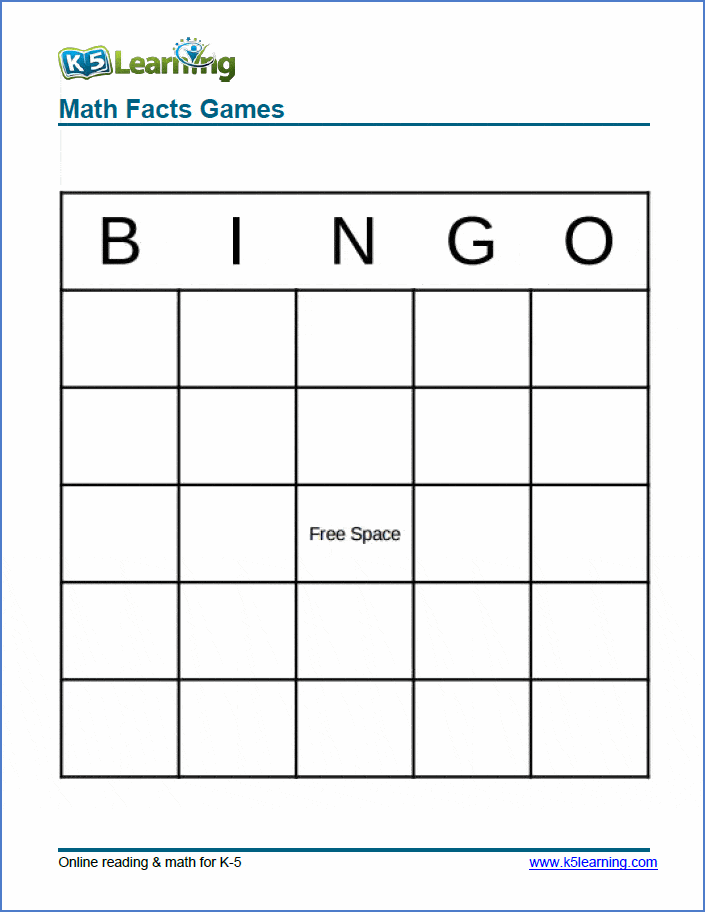Practice! Practice! Practice! That’s what it takes for students to learn their addition, subtraction, multiplication and division tables. Rote drill is the way many of us learned our math facts. Remember how our teachers timed how fast we could present the latest times table in front of the whole class?
Accuracy and speed are the goals, but does repetitive rote learning have to be the only way for students to learn their math facts? Let’s find some new ways for your kids to learn their math facts.
First, you’ll need some math facts flashcards. Lots of sites have free printable flashcards. You can just search for them online. Or just use ours.
Now to the games.
Math Facts BINGO
Materials needed:
A set of BINGO card – one for each player. Here's a BINGO template for you to use.
A set of flashcards for the math facts you are working on.
Preparation:
Print off the number of BINGO cards you need for each player.
Print off the set of math facts flashcards you are practicing.
Write the sums in random order on the BINGO cards.
How to play:
Hand out the BINGO cards to all the players.
As the caller you will call out the math fact, not the sum. So for example, if you are working on addition math facts and the math fact is 2+6 = 8, you will call out 2 + 6, and your kids will cross out, or put a marker down on, the number 8 on their BINGO cards.
The rest of the game follows normal BINGO rules. Players call out BINGO for when they have filled in a row or the entire card – depending on how you choose to play.
Mix up the BINGO cards and play again.
Math Facts Hide and Seek
Materials needed:
A set of flashcards for the math facts you are working on.
Preparation:
Print off the set of math facts flashcards you are practicing.
Rather than folding over each card for the sum to show on the reverse of the card, cut each card in two – so the math fact and its sum are now on separate cards.
Hide the sum cards around a room or your entire house.
How to play:
Give each kid a math fact card – say 12 x 8. Now they have to go find the hidden card with the correct sum. In this case that correct sum card would be 96.
The first kid to find their card wins.
If you want to make the game longer, give them a set of math fact cards – say three at a time.
If you want to make it even more competitive, don’t have the same amount of sum cards hidden as the math facts cards you hand out, so the kids will now only win if they are the first to find that sum card.
Math Facts Go Fish
Materials needed:
A set of flashcards for the math facts you are working on.
Preparation:
Print off the set of math facts flashcards you are practicing.
Rather than folding over each card for the sum to show on the reverse of the card, cut each card in two – so the math fact and its sum are now on separate cards.
How to play:
Half of the kids are going to start with the math facts cards and the other half with the sum cards.
The first child will have the math facts cards and ask the kids with the sum cards, do you have this math fact, let’s say 2 + 4. “Do you have 2 + 4?"
The child with the sum cards will then have to review their sum cards, and hand over the card with the number 6. If they have it. If not, they’ll say – go fish.
The child will pick up a card that can either be a sum or a math fact.
The child with a sum card will ask a child with math facts cards, if they have a card that adds up to 8. If the child with the math facts cards has a card that says “4+4” or “2+6”, he will have to hand it over. If not – go fish.
As the game progresses, the kids will end up having a mixture of sum cards and math fact cards. At this point, they can ask any other kids for either a math facts card or a sum card. They'll just have to remember to ask for the opposite of the card they want - so they are matching up math facts cards with their equivalent sums.
First child to put all their matched cards down wins.


